SSCI 1300U - Social Problems: Intersection of Inequalities Essay
VerifiedAdded on 2022/08/15
|5
|1460
|11
Essay
AI Summary
This essay examines the intersection of social inequalities, specifically focusing on gender and racial discrimination and their combined impact on various social problems. The student explores how these inequalities, rather than being mutually exclusive, often intersect to create complex challenges, as evidenced by disparities in employment, healthcare, and experiences of violence. The essay utilizes the difference theory and theory of mind to explain the dynamics of discrimination and its effect on marginalized groups. The author references academic sources to support the analysis of the problems faced by women and other minority groups. The essay concludes by emphasizing the severity of the social problems that arise when gender and race discrimination intersect, and how it affects society. The essay also touches upon how men with diverse sexual orientation have also complained about some similar type of discrimination, but it is not widely highlighted.
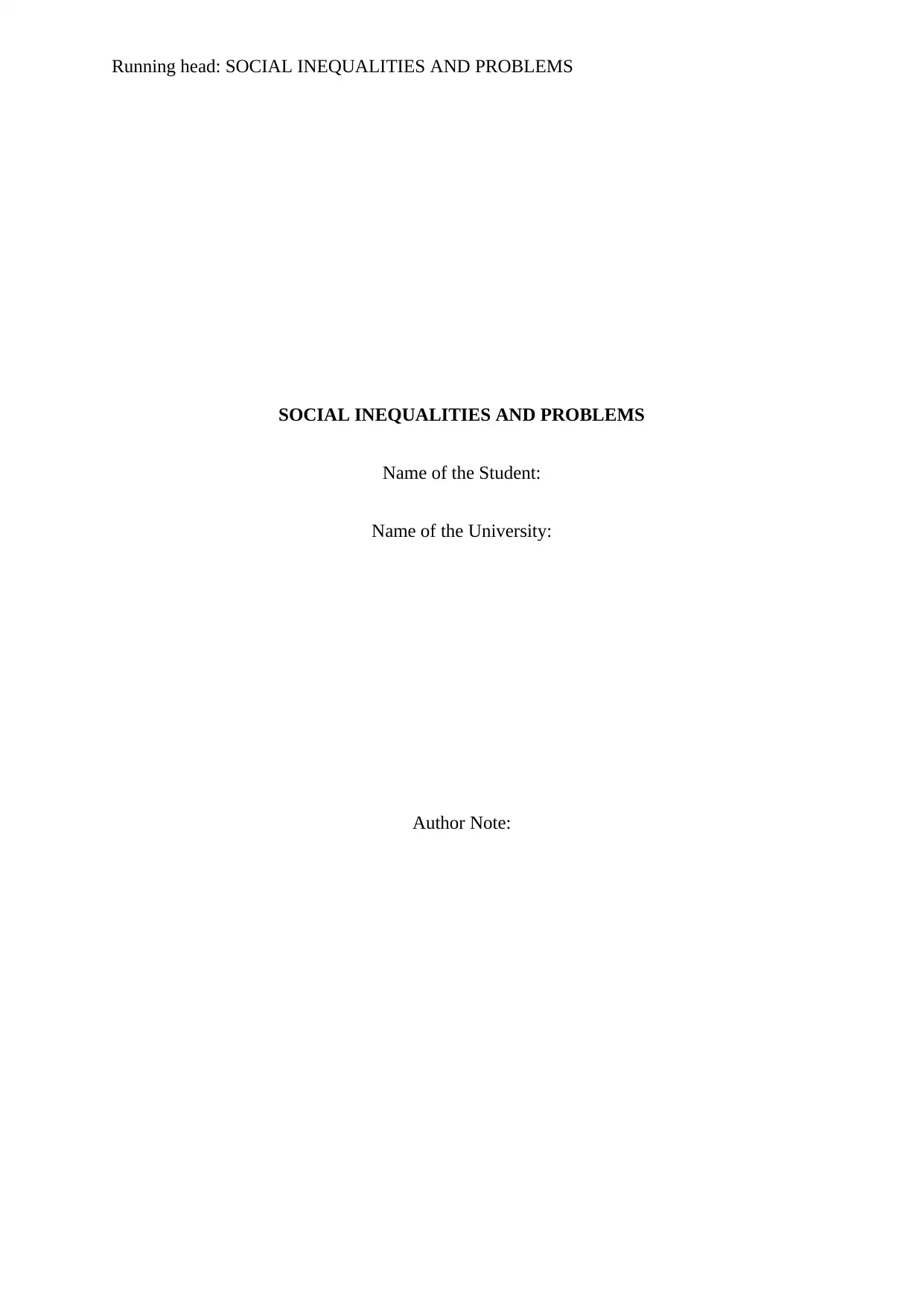
Running head: SOCIAL INEQUALITIES AND PROBLEMS
SOCIAL INEQUALITIES AND PROBLEMS
Name of the Student:
Name of the University:
Author Note:
SOCIAL INEQUALITIES AND PROBLEMS
Name of the Student:
Name of the University:
Author Note:
Paraphrase This Document
Need a fresh take? Get an instant paraphrase of this document with our AI Paraphraser
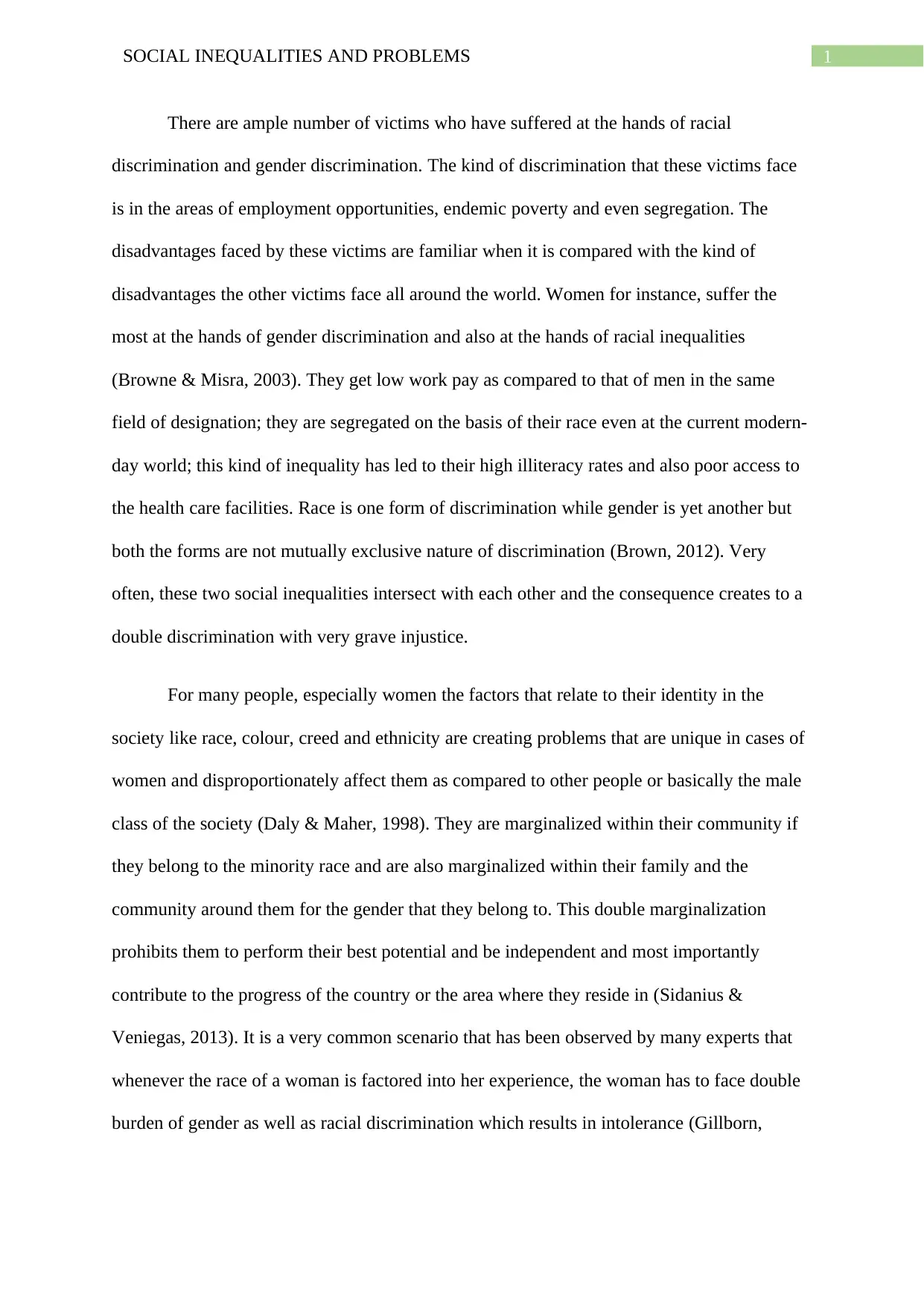
1SOCIAL INEQUALITIES AND PROBLEMS
There are ample number of victims who have suffered at the hands of racial
discrimination and gender discrimination. The kind of discrimination that these victims face
is in the areas of employment opportunities, endemic poverty and even segregation. The
disadvantages faced by these victims are familiar when it is compared with the kind of
disadvantages the other victims face all around the world. Women for instance, suffer the
most at the hands of gender discrimination and also at the hands of racial inequalities
(Browne & Misra, 2003). They get low work pay as compared to that of men in the same
field of designation; they are segregated on the basis of their race even at the current modern-
day world; this kind of inequality has led to their high illiteracy rates and also poor access to
the health care facilities. Race is one form of discrimination while gender is yet another but
both the forms are not mutually exclusive nature of discrimination (Brown, 2012). Very
often, these two social inequalities intersect with each other and the consequence creates to a
double discrimination with very grave injustice.
For many people, especially women the factors that relate to their identity in the
society like race, colour, creed and ethnicity are creating problems that are unique in cases of
women and disproportionately affect them as compared to other people or basically the male
class of the society (Daly & Maher, 1998). They are marginalized within their community if
they belong to the minority race and are also marginalized within their family and the
community around them for the gender that they belong to. This double marginalization
prohibits them to perform their best potential and be independent and most importantly
contribute to the progress of the country or the area where they reside in (Sidanius &
Veniegas, 2013). It is a very common scenario that has been observed by many experts that
whenever the race of a woman is factored into her experience, the woman has to face double
burden of gender as well as racial discrimination which results in intolerance (Gillborn,
There are ample number of victims who have suffered at the hands of racial
discrimination and gender discrimination. The kind of discrimination that these victims face
is in the areas of employment opportunities, endemic poverty and even segregation. The
disadvantages faced by these victims are familiar when it is compared with the kind of
disadvantages the other victims face all around the world. Women for instance, suffer the
most at the hands of gender discrimination and also at the hands of racial inequalities
(Browne & Misra, 2003). They get low work pay as compared to that of men in the same
field of designation; they are segregated on the basis of their race even at the current modern-
day world; this kind of inequality has led to their high illiteracy rates and also poor access to
the health care facilities. Race is one form of discrimination while gender is yet another but
both the forms are not mutually exclusive nature of discrimination (Brown, 2012). Very
often, these two social inequalities intersect with each other and the consequence creates to a
double discrimination with very grave injustice.
For many people, especially women the factors that relate to their identity in the
society like race, colour, creed and ethnicity are creating problems that are unique in cases of
women and disproportionately affect them as compared to other people or basically the male
class of the society (Daly & Maher, 1998). They are marginalized within their community if
they belong to the minority race and are also marginalized within their family and the
community around them for the gender that they belong to. This double marginalization
prohibits them to perform their best potential and be independent and most importantly
contribute to the progress of the country or the area where they reside in (Sidanius &
Veniegas, 2013). It is a very common scenario that has been observed by many experts that
whenever the race of a woman is factored into her experience, the woman has to face double
burden of gender as well as racial discrimination which results in intolerance (Gillborn,
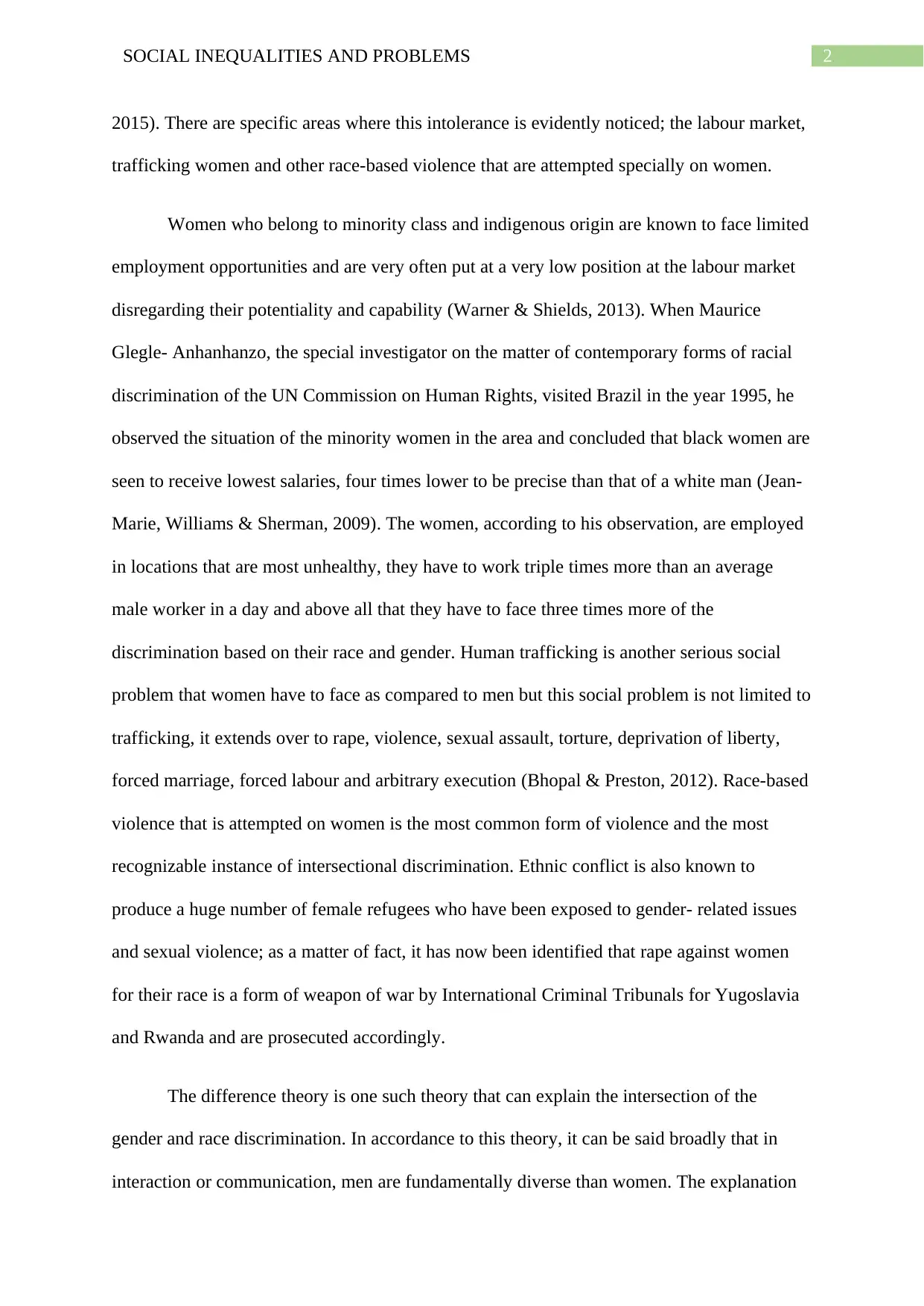
2SOCIAL INEQUALITIES AND PROBLEMS
2015). There are specific areas where this intolerance is evidently noticed; the labour market,
trafficking women and other race-based violence that are attempted specially on women.
Women who belong to minority class and indigenous origin are known to face limited
employment opportunities and are very often put at a very low position at the labour market
disregarding their potentiality and capability (Warner & Shields, 2013). When Maurice
Glegle- Anhanhanzo, the special investigator on the matter of contemporary forms of racial
discrimination of the UN Commission on Human Rights, visited Brazil in the year 1995, he
observed the situation of the minority women in the area and concluded that black women are
seen to receive lowest salaries, four times lower to be precise than that of a white man (Jean-
Marie, Williams & Sherman, 2009). The women, according to his observation, are employed
in locations that are most unhealthy, they have to work triple times more than an average
male worker in a day and above all that they have to face three times more of the
discrimination based on their race and gender. Human trafficking is another serious social
problem that women have to face as compared to men but this social problem is not limited to
trafficking, it extends over to rape, violence, sexual assault, torture, deprivation of liberty,
forced marriage, forced labour and arbitrary execution (Bhopal & Preston, 2012). Race-based
violence that is attempted on women is the most common form of violence and the most
recognizable instance of intersectional discrimination. Ethnic conflict is also known to
produce a huge number of female refugees who have been exposed to gender- related issues
and sexual violence; as a matter of fact, it has now been identified that rape against women
for their race is a form of weapon of war by International Criminal Tribunals for Yugoslavia
and Rwanda and are prosecuted accordingly.
The difference theory is one such theory that can explain the intersection of the
gender and race discrimination. In accordance to this theory, it can be said broadly that in
interaction or communication, men are fundamentally diverse than women. The explanation
2015). There are specific areas where this intolerance is evidently noticed; the labour market,
trafficking women and other race-based violence that are attempted specially on women.
Women who belong to minority class and indigenous origin are known to face limited
employment opportunities and are very often put at a very low position at the labour market
disregarding their potentiality and capability (Warner & Shields, 2013). When Maurice
Glegle- Anhanhanzo, the special investigator on the matter of contemporary forms of racial
discrimination of the UN Commission on Human Rights, visited Brazil in the year 1995, he
observed the situation of the minority women in the area and concluded that black women are
seen to receive lowest salaries, four times lower to be precise than that of a white man (Jean-
Marie, Williams & Sherman, 2009). The women, according to his observation, are employed
in locations that are most unhealthy, they have to work triple times more than an average
male worker in a day and above all that they have to face three times more of the
discrimination based on their race and gender. Human trafficking is another serious social
problem that women have to face as compared to men but this social problem is not limited to
trafficking, it extends over to rape, violence, sexual assault, torture, deprivation of liberty,
forced marriage, forced labour and arbitrary execution (Bhopal & Preston, 2012). Race-based
violence that is attempted on women is the most common form of violence and the most
recognizable instance of intersectional discrimination. Ethnic conflict is also known to
produce a huge number of female refugees who have been exposed to gender- related issues
and sexual violence; as a matter of fact, it has now been identified that rape against women
for their race is a form of weapon of war by International Criminal Tribunals for Yugoslavia
and Rwanda and are prosecuted accordingly.
The difference theory is one such theory that can explain the intersection of the
gender and race discrimination. In accordance to this theory, it can be said broadly that in
interaction or communication, men are fundamentally diverse than women. The explanation
⊘ This is a preview!⊘
Do you want full access?
Subscribe today to unlock all pages.

Trusted by 1+ million students worldwide
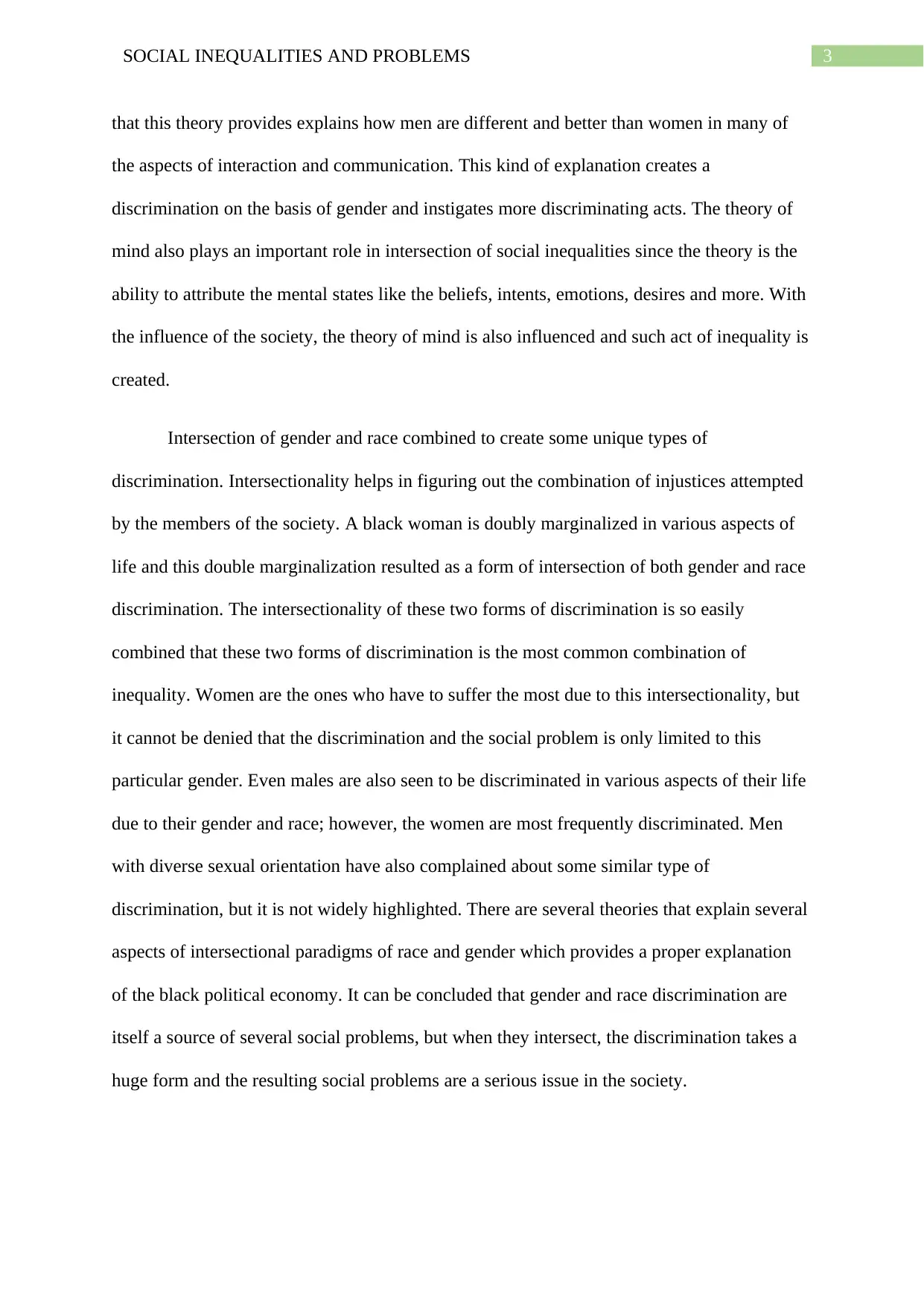
3SOCIAL INEQUALITIES AND PROBLEMS
that this theory provides explains how men are different and better than women in many of
the aspects of interaction and communication. This kind of explanation creates a
discrimination on the basis of gender and instigates more discriminating acts. The theory of
mind also plays an important role in intersection of social inequalities since the theory is the
ability to attribute the mental states like the beliefs, intents, emotions, desires and more. With
the influence of the society, the theory of mind is also influenced and such act of inequality is
created.
Intersection of gender and race combined to create some unique types of
discrimination. Intersectionality helps in figuring out the combination of injustices attempted
by the members of the society. A black woman is doubly marginalized in various aspects of
life and this double marginalization resulted as a form of intersection of both gender and race
discrimination. The intersectionality of these two forms of discrimination is so easily
combined that these two forms of discrimination is the most common combination of
inequality. Women are the ones who have to suffer the most due to this intersectionality, but
it cannot be denied that the discrimination and the social problem is only limited to this
particular gender. Even males are also seen to be discriminated in various aspects of their life
due to their gender and race; however, the women are most frequently discriminated. Men
with diverse sexual orientation have also complained about some similar type of
discrimination, but it is not widely highlighted. There are several theories that explain several
aspects of intersectional paradigms of race and gender which provides a proper explanation
of the black political economy. It can be concluded that gender and race discrimination are
itself a source of several social problems, but when they intersect, the discrimination takes a
huge form and the resulting social problems are a serious issue in the society.
that this theory provides explains how men are different and better than women in many of
the aspects of interaction and communication. This kind of explanation creates a
discrimination on the basis of gender and instigates more discriminating acts. The theory of
mind also plays an important role in intersection of social inequalities since the theory is the
ability to attribute the mental states like the beliefs, intents, emotions, desires and more. With
the influence of the society, the theory of mind is also influenced and such act of inequality is
created.
Intersection of gender and race combined to create some unique types of
discrimination. Intersectionality helps in figuring out the combination of injustices attempted
by the members of the society. A black woman is doubly marginalized in various aspects of
life and this double marginalization resulted as a form of intersection of both gender and race
discrimination. The intersectionality of these two forms of discrimination is so easily
combined that these two forms of discrimination is the most common combination of
inequality. Women are the ones who have to suffer the most due to this intersectionality, but
it cannot be denied that the discrimination and the social problem is only limited to this
particular gender. Even males are also seen to be discriminated in various aspects of their life
due to their gender and race; however, the women are most frequently discriminated. Men
with diverse sexual orientation have also complained about some similar type of
discrimination, but it is not widely highlighted. There are several theories that explain several
aspects of intersectional paradigms of race and gender which provides a proper explanation
of the black political economy. It can be concluded that gender and race discrimination are
itself a source of several social problems, but when they intersect, the discrimination takes a
huge form and the resulting social problems are a serious issue in the society.
Paraphrase This Document
Need a fresh take? Get an instant paraphrase of this document with our AI Paraphraser
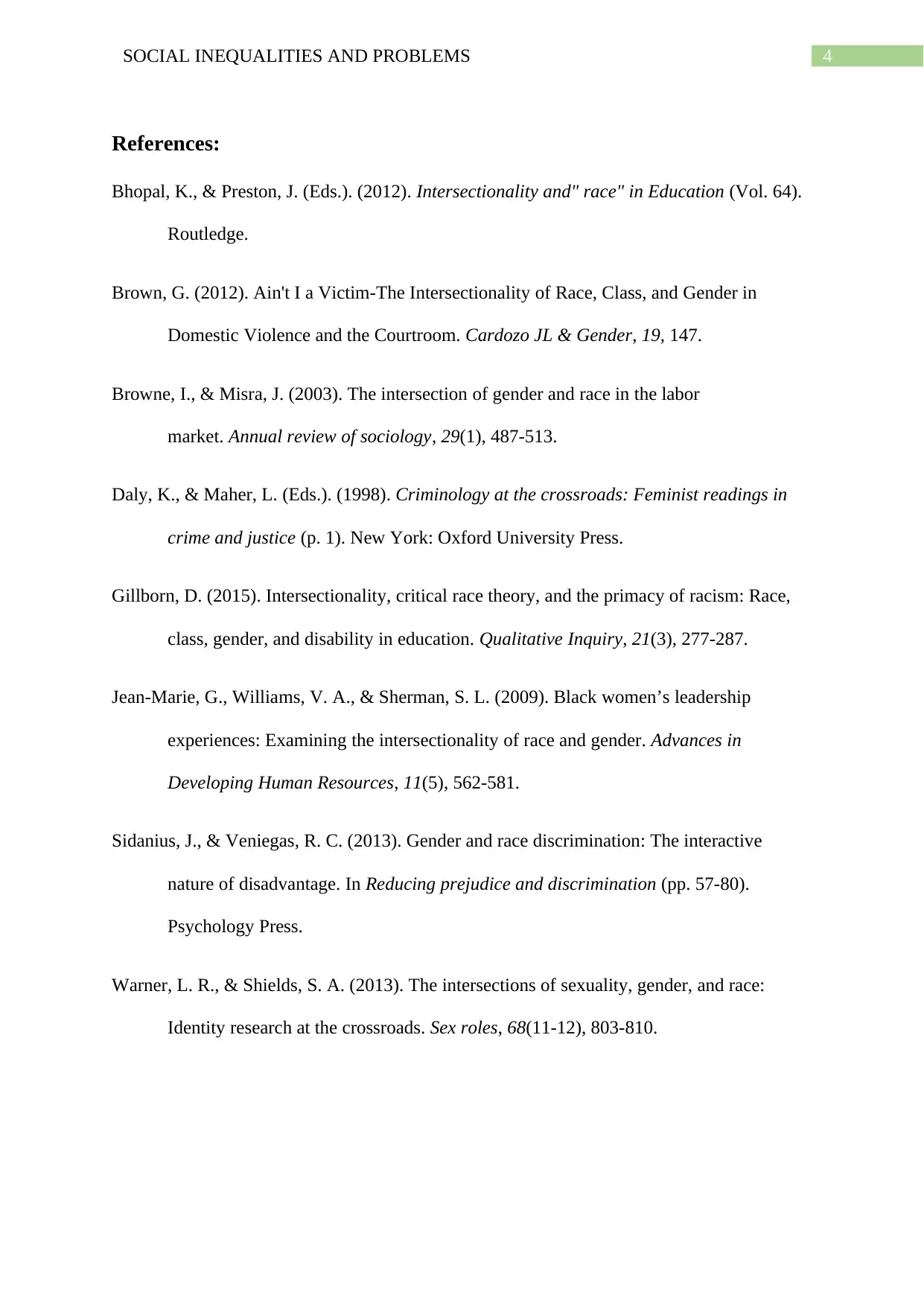
4SOCIAL INEQUALITIES AND PROBLEMS
References:
Bhopal, K., & Preston, J. (Eds.). (2012). Intersectionality and" race" in Education (Vol. 64).
Routledge.
Brown, G. (2012). Ain't I a Victim-The Intersectionality of Race, Class, and Gender in
Domestic Violence and the Courtroom. Cardozo JL & Gender, 19, 147.
Browne, I., & Misra, J. (2003). The intersection of gender and race in the labor
market. Annual review of sociology, 29(1), 487-513.
Daly, K., & Maher, L. (Eds.). (1998). Criminology at the crossroads: Feminist readings in
crime and justice (p. 1). New York: Oxford University Press.
Gillborn, D. (2015). Intersectionality, critical race theory, and the primacy of racism: Race,
class, gender, and disability in education. Qualitative Inquiry, 21(3), 277-287.
Jean-Marie, G., Williams, V. A., & Sherman, S. L. (2009). Black women’s leadership
experiences: Examining the intersectionality of race and gender. Advances in
Developing Human Resources, 11(5), 562-581.
Sidanius, J., & Veniegas, R. C. (2013). Gender and race discrimination: The interactive
nature of disadvantage. In Reducing prejudice and discrimination (pp. 57-80).
Psychology Press.
Warner, L. R., & Shields, S. A. (2013). The intersections of sexuality, gender, and race:
Identity research at the crossroads. Sex roles, 68(11-12), 803-810.
References:
Bhopal, K., & Preston, J. (Eds.). (2012). Intersectionality and" race" in Education (Vol. 64).
Routledge.
Brown, G. (2012). Ain't I a Victim-The Intersectionality of Race, Class, and Gender in
Domestic Violence and the Courtroom. Cardozo JL & Gender, 19, 147.
Browne, I., & Misra, J. (2003). The intersection of gender and race in the labor
market. Annual review of sociology, 29(1), 487-513.
Daly, K., & Maher, L. (Eds.). (1998). Criminology at the crossroads: Feminist readings in
crime and justice (p. 1). New York: Oxford University Press.
Gillborn, D. (2015). Intersectionality, critical race theory, and the primacy of racism: Race,
class, gender, and disability in education. Qualitative Inquiry, 21(3), 277-287.
Jean-Marie, G., Williams, V. A., & Sherman, S. L. (2009). Black women’s leadership
experiences: Examining the intersectionality of race and gender. Advances in
Developing Human Resources, 11(5), 562-581.
Sidanius, J., & Veniegas, R. C. (2013). Gender and race discrimination: The interactive
nature of disadvantage. In Reducing prejudice and discrimination (pp. 57-80).
Psychology Press.
Warner, L. R., & Shields, S. A. (2013). The intersections of sexuality, gender, and race:
Identity research at the crossroads. Sex roles, 68(11-12), 803-810.
1 out of 5
Related Documents
Your All-in-One AI-Powered Toolkit for Academic Success.
+13062052269
info@desklib.com
Available 24*7 on WhatsApp / Email
![[object Object]](/_next/static/media/star-bottom.7253800d.svg)
Unlock your academic potential
Copyright © 2020–2025 A2Z Services. All Rights Reserved. Developed and managed by ZUCOL.



